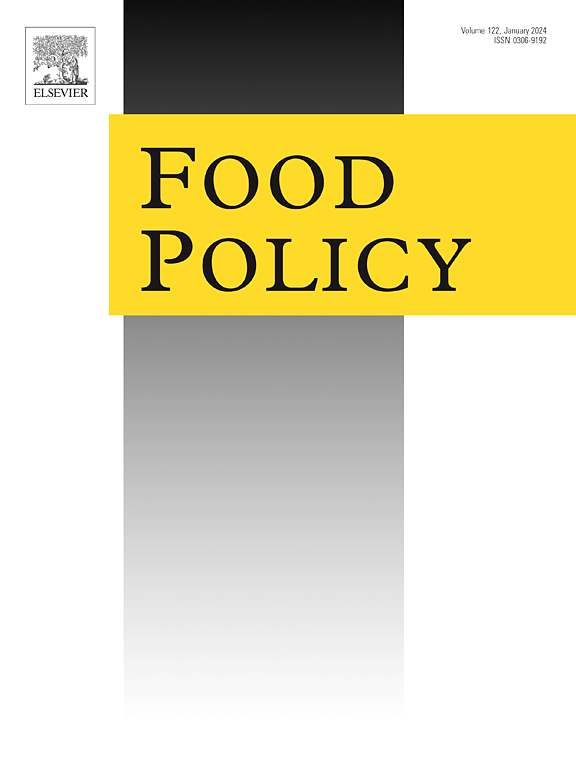Can changing the meal sequence in school canteens reduce vegetable food waste? A cluster randomized control trial
IF 6
1区 经济学
Q1 AGRICULTURAL ECONOMICS & POLICY
引用次数: 0
Abstract
School canteens are crucial drivers for stimulating sustainable eating habits of children in line with global sustainability objectives. Using a participatory approach, we co-design a choice-architecture intervention to assess whether inverting the sequence of Mediterranean lunch dishes served in school canteens is effective in reducing food waste. We implement a randomized control trial using 26 Italian schools, creating one of the largest and the most diverse samples achieved so far for such an experiment. Hence, our analysis yields evidence of internal and external validity far beyond existing interventions which consider only a few education institutions without random selection. A food mass flow analysis of the weighed prepared food, serving waste and plate waste per meal course suggests that in primary school canteens 29% of the lunch prepared gets wasted, i.e., 22,000 tons per year in Italy. Big catering providers are found to produce 23% more food waste. Prioritizing the vegetable side dish as first course has heterogeneous effects across school clusters changing the share of plate waste in total vegetable servings between −26 pp to + 32 pp. Also, the side dish plate waste depends on the type of vegetables served. Differences in lunch implementation and food and eating environments across schools appear to dominate the effectiveness of the intervention, hence, no treatment effect is found for the full sample. Upscaling of the dish reordering as a binding policy strategy for the entire regional territory is therefore not recommended. We conclude that policymakers and researchers should more often use citizen science to maximize benefits for society.
改变学校食堂的用餐顺序能否减少蔬菜食物浪费?一组随机对照试验
学校食堂是促进儿童养成可持续饮食习惯的关键驱动力,符合全球可持续发展目标。采用参与式方法,我们共同设计了一个选择架构干预,以评估颠倒学校食堂供应地中海午餐的顺序是否能有效减少食物浪费。我们使用26所意大利学校实施了一项随机对照试验,创建了迄今为止此类实验中最大和最多样化的样本之一。因此,我们的分析产生了内部和外部有效性的证据,远远超出了现有的干预措施,这些干预措施只考虑少数教育机构而没有随机选择。一项对称重后的准备食物、餐厨垃圾和餐盘垃圾进行的食物质量流分析表明,在意大利,小学食堂29%的准备午餐被浪费,即每年浪费22,000吨。调查发现,大型餐饮供应商产生的食物垃圾要多出23%。将蔬菜配菜作为第一道菜的优先顺序在学校集群中具有不同的影响,改变了盘子浪费在总蔬菜服务中的份额,从- 26页到+ 32页。此外,配菜盘子浪费取决于所服务的蔬菜类型。不同学校的午餐实施和饮食环境的差异似乎主导了干预的有效性,因此,在整个样本中没有发现治疗效果。因此,不建议将重新订餐作为一项对整个区域具有约束力的政策策略。我们的结论是,政策制定者和研究人员应该更多地利用公民科学来实现社会利益最大化。
本文章由计算机程序翻译,如有差异,请以英文原文为准。
求助全文
约1分钟内获得全文
求助全文
来源期刊

Food Policy
管理科学-农业经济与政策
CiteScore
11.40
自引率
4.60%
发文量
128
审稿时长
62 days
期刊介绍:
Food Policy is a multidisciplinary journal publishing original research and novel evidence on issues in the formulation, implementation, and evaluation of policies for the food sector in developing, transition, and advanced economies.
Our main focus is on the economic and social aspect of food policy, and we prioritize empirical studies informing international food policy debates. Provided that articles make a clear and explicit contribution to food policy debates of international interest, we consider papers from any of the social sciences. Papers from other disciplines (e.g., law) will be considered only if they provide a key policy contribution, and are written in a style which is accessible to a social science readership.
 求助内容:
求助内容: 应助结果提醒方式:
应助结果提醒方式:


